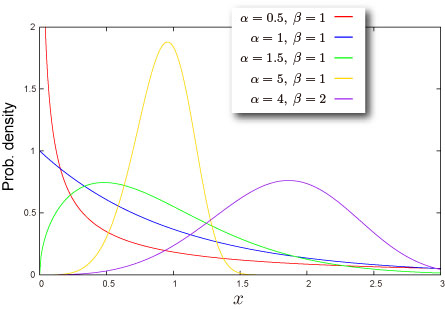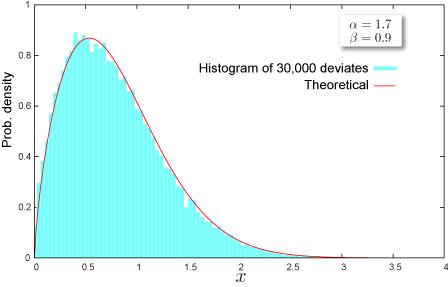Weibull distribution
Where do you meet this distribution?
Shape of Distribution
Basic Properties
- Two parameters
are required (How can you get these).
- Continuous distribution defined on semi-bounded range
- This distribution is always asymmetric.
Probability
- How to compute these on Excel.
1 2 3 4 5 6 7 A B Data Description 0.5 Value for which you want the distribution 8 Value of parameter Alpha 2 Value of parameter Beta Formula Description (Result) =NTWEIBULLDIST(A2,A3,A4,TRUE) Cumulative distribution function for the terms above =NTWEIBULLDIST(A2,A3,A4,FALSE) Probability density function for the terms above - Cumulative distribution function
- Probability density function
- Function reference : NTWEIBULLDIST
- Cumulative distribution function

Quantile
- Inverse function of cumulative distribution function
- How to compute this on Excel.
1 2 3 4 5 6 A B Data Description 0.7 Probability associated with the distribution 1.7 Value of parameter Alpha 0.9 Value of parameter Beta Formula Description (Result) =WEIBULLINV(A2,A3,A4) Inverse of the cumulative distribution function for the terms above - Function reference : NTWEIBULLINV
Characteristics
Mean – Where is the “center” of the distribution? (Definition)
- Mean of the distribution is given as
where
is gamma function.
- How to compute this on Excel
1 2 3 4 5 A B Data Description 8 Value of parameter Alpha 2 Value of parameter Beta Formula Description (Result) =NTWEIBULLMEAN(A2,A3) Mean of the distribution for the terms above - Function reference : NTWEIBULLMEAN
Standard Deviation – How wide does the distribution spread? (Definition)
- Variance of the distribution is given as
where
,
is mean of the distribution and
is gamma function
Standard Deviation is a positive square root of Variance.
- How to compute this on Excel
1 2 3 4 5 A B Data Description 8 Value of parameter Alpha 2 Value of parameter Beta Formula Description (Result) =NTWEIBULLSTDEV(A2,A3) Standard deviation of the distribution for the terms above - Function reference : NTWEIBULLSTDEV
Skewness – Which side is the distribution distorted into? (Definition)
- Skewness of the distribution is given as
where
,
is mean of the distribution,
is variance of the distribution,
is gamma function and
is standard deviation of the distribution.
- How to compute this on Excel
1 2 3 4 5 A B Data Description 8 Value of parameter Alpha 2 Value of parameter Beta Formula Description (Result) =NTWEIBULLSKEW(A2,A3) Skewness of the distribution for the terms above - Function reference : NTWEIBULLSKEW
Kurtosis – Sharp or Dull, consequently Fat Tail or Thin Tail (Definition)
- Kurtosis of the distribution is given as
where
,
is gamma function,
is mean of the distribution,
is standard deviation of the distribution and
is skewness of the distribution.
- How to compute this on Excel
1 2 3 4 5 A B Data Description 8 Value of parameter Alpha 2 Value of parameter Beta Formula Description (Result) =NTWEIBULLKURT(A2,A3) Kurtosis of the distribution for the terms above - Function reference : NTWEIBULLKURT
Random Numbers
- Random number x is generated by inverse function method, which is for uniform random U,
- How to generate random numbers on Excel.
1 2 3 4 5 A B Data Description 0.5 Value of parameter Alpha 0.5 Value of parameter Beta Formula Description (Result) =NTRANDWEIBULL(100,A2,A3,0) 100 Weibull deviates based on Mersenne-Twister algorithm for which the parameters above Note The formula in the example must be entered as an array formula. After copying the example to a blank worksheet, select the range A5:A104 starting with the formula cell. Press F2, and then press CTRL+SHIFT+ENTER.

NtRand Functions
- If you already have parameters of the distribution
- Generating random numbers based on Mersenne Twister algorithm: NTRANDWEIBULL
- Computing probability : NTWEIBULLDIST
- Computing mean : NTWEIBULLMEAN
- Computing standard deviation : NTWEIBULLSTDEV
- Computing skewness : NTWEIBULLSKEW
- Computing kurtosis : NTWEIBULLKURT
- Computing moments above at once : NTWEIBULLMOM
- If you know mean and standard deviation of the distribution
- Estimating parameters of the distribution:NTWEIBULLPARAM

 RSS
RSS
